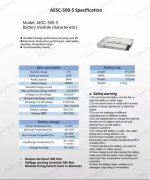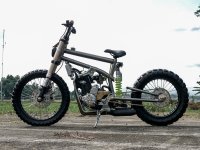ta0s
10 µW
I appreciate the stream of inspiration that comes through here.
I'm a lifelong builder of things, and next on my list is an electric motorbike.
I am comfortable with 90% of the build I have in mind, inspired by the photo I've attached. It's a BMX style, but obviously electric. it will be for strictly on road use. I've built many frames for many purposes, and I think this will be a reasonably easy one to build.
I have a reasonable amount of experience with electrical engineering, battery building, and specifically high amperage DC so I don't think I need advice on how to put things together at this stage (unless there is some glaring error in what I'm presenting below).. - more what to put together!
For starters, I want things to peak at around 40kw. I may occasionally want this power to turn my frown upside down, but likely only for a few seconds at a time.
Based on this, I'm looking at the 12kw qs273 17x6 hub motor, at the torquiest winding.
I'm thinking 2 x 12s2p banks of gen2 Nissan Leaf battery modules, 96v total. Each bank running a JBD 300a BMS. For a total of 600 theoretical amps and drawing approximately 3.5C from each battery at this peak if possible. (I've attached a photo of the specs of each module)
To supply a theoretical potential of 57kw, I'm looking at something around a 600amp controller - something like the Kelly Controller KLS96601.
Notwithstanding all the other important details, I'd expect that this set up could deliver my desired 40kw, and probably more. What particularly excites me is the promise of 350+N.m of on tap torque. That sounds very fun.
My questions are:
In general are my numbers achievable/reasonable with the kind of price point of the parts I've listed? I've read a lot about 20-30kw but I haven't been able to find a lot about the 40kw+ space. Is it because this kind of power is demanding too much of the readily accessible Chinese parts? Or is it just that 40kw+ just isn't really desired for the investment required?
With respect to the QS 273 12KW motor (17inch 12KW Hub Motor for super Motorcycle, Bike and Scooter...) - is anyone on here running this sort of wattage successfully long-term? I'm not totally opposed to a mid mount, and I'm aware of the advantages - However for this specific build being a street bike the benefits of building ease and convenience I feel outweighs the benefits of a mid mount. The only thing that could swing me as if someone has built a high-performance bike based on this motor and the handling is really bad due to the high rotating weight. I do want this bike to feel snappy and fun, and I definitely don't want to compromise handling over build-ease
With respect to the BMS's - What are people's preferences in terms of brands (and features). I'm not experienced with such high amperage stand-alone BMSs, but are familiar with lithium chemistry and all of the care requirements of it. I'm also unsure if I need to take into account that the batteries I want to use are LiMn2O4.. The voltage cut-offs are the same - but keen to hear from anyone with experience here.
With respect to the controller - I'm pretty keen on having a regenerative brake function, ideally this would be analog, i.e. variable rate of application - as opposed to a "switch". Does anyone have experienced with high amperage controllers that support this? Other than regenerative brake, I'd looking for something that is as plug and play as possible. I prefer to not have to spend lots of time tuning. My preference would be to hook it up, set the basic configuration up and be able to have the controller and motor produce as close to the configured throughput as possible.
With respect to the concept - I realise this is a "heavy" build. I'm 100kg. Acceleration and handling are both high priorities for this build. Top speed, less so (140kmh would be absolute top, 120kmh satisfactory). If lighter hardware and battery would provide similar "felt" torque, I'd love to understand this better.
Thanks everyone, and looking forward to sharing progress as I go.
I'm a lifelong builder of things, and next on my list is an electric motorbike.
I am comfortable with 90% of the build I have in mind, inspired by the photo I've attached. It's a BMX style, but obviously electric. it will be for strictly on road use. I've built many frames for many purposes, and I think this will be a reasonably easy one to build.
I have a reasonable amount of experience with electrical engineering, battery building, and specifically high amperage DC so I don't think I need advice on how to put things together at this stage (unless there is some glaring error in what I'm presenting below).. - more what to put together!
For starters, I want things to peak at around 40kw. I may occasionally want this power to turn my frown upside down, but likely only for a few seconds at a time.
Based on this, I'm looking at the 12kw qs273 17x6 hub motor, at the torquiest winding.
I'm thinking 2 x 12s2p banks of gen2 Nissan Leaf battery modules, 96v total. Each bank running a JBD 300a BMS. For a total of 600 theoretical amps and drawing approximately 3.5C from each battery at this peak if possible. (I've attached a photo of the specs of each module)
To supply a theoretical potential of 57kw, I'm looking at something around a 600amp controller - something like the Kelly Controller KLS96601.
Notwithstanding all the other important details, I'd expect that this set up could deliver my desired 40kw, and probably more. What particularly excites me is the promise of 350+N.m of on tap torque. That sounds very fun.
My questions are:
In general are my numbers achievable/reasonable with the kind of price point of the parts I've listed? I've read a lot about 20-30kw but I haven't been able to find a lot about the 40kw+ space. Is it because this kind of power is demanding too much of the readily accessible Chinese parts? Or is it just that 40kw+ just isn't really desired for the investment required?
With respect to the QS 273 12KW motor (17inch 12KW Hub Motor for super Motorcycle, Bike and Scooter...) - is anyone on here running this sort of wattage successfully long-term? I'm not totally opposed to a mid mount, and I'm aware of the advantages - However for this specific build being a street bike the benefits of building ease and convenience I feel outweighs the benefits of a mid mount. The only thing that could swing me as if someone has built a high-performance bike based on this motor and the handling is really bad due to the high rotating weight. I do want this bike to feel snappy and fun, and I definitely don't want to compromise handling over build-ease
With respect to the BMS's - What are people's preferences in terms of brands (and features). I'm not experienced with such high amperage stand-alone BMSs, but are familiar with lithium chemistry and all of the care requirements of it. I'm also unsure if I need to take into account that the batteries I want to use are LiMn2O4.. The voltage cut-offs are the same - but keen to hear from anyone with experience here.
With respect to the controller - I'm pretty keen on having a regenerative brake function, ideally this would be analog, i.e. variable rate of application - as opposed to a "switch". Does anyone have experienced with high amperage controllers that support this? Other than regenerative brake, I'd looking for something that is as plug and play as possible. I prefer to not have to spend lots of time tuning. My preference would be to hook it up, set the basic configuration up and be able to have the controller and motor produce as close to the configured throughput as possible.
With respect to the concept - I realise this is a "heavy" build. I'm 100kg. Acceleration and handling are both high priorities for this build. Top speed, less so (140kmh would be absolute top, 120kmh satisfactory). If lighter hardware and battery would provide similar "felt" torque, I'd love to understand this better.
Thanks everyone, and looking forward to sharing progress as I go.
Attachments
Last edited:



